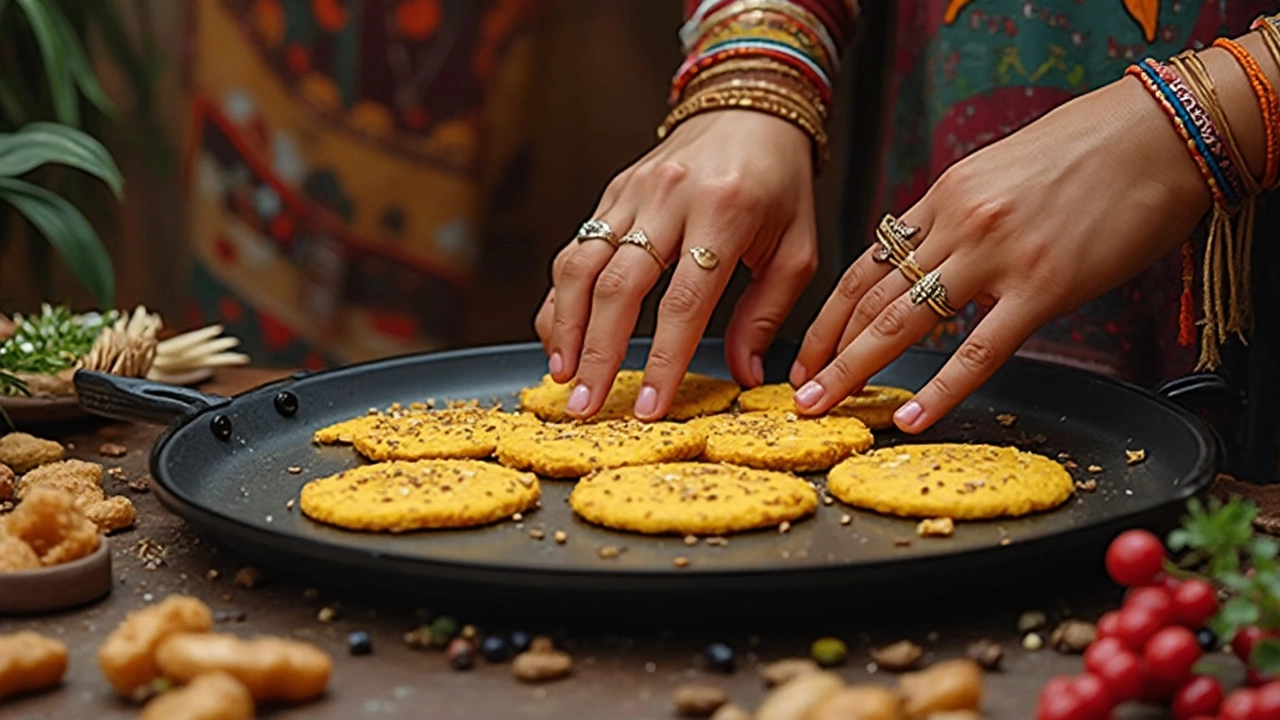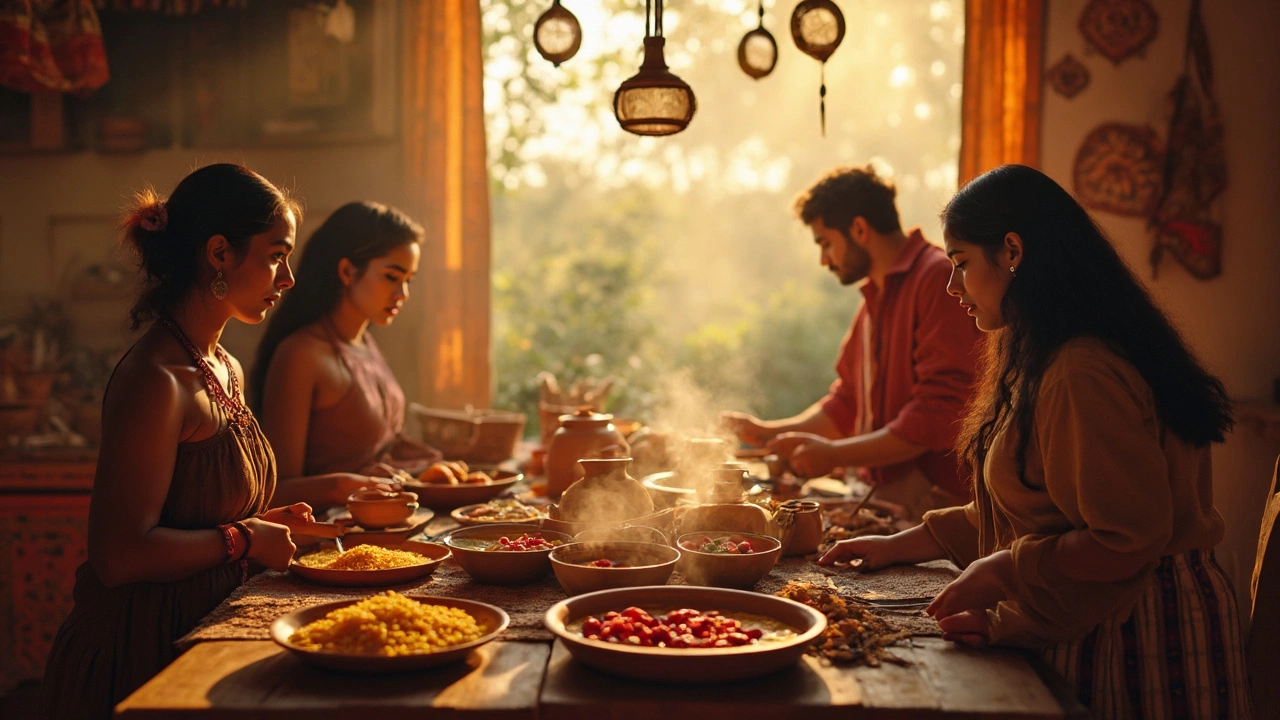25 Apr 2025
- 0 Comments
Forget pancakes and bacon for a second. Curious about what Native American Indians actually eat for breakfast? Their morning meals go way beyond the usual suspects. Many traditional breakfasts use local ingredients like corn, beans, squash, berries, or fish. Think cornmeal porridge, frybread, or simple stews—fast, filling, and full of flavor.
Here’s the cool part: these foods aren’t just picked for taste. They’re all about giving energy and holding off hunger—handy for busy people, then and now. Cornmeal mush (picture a warm, creamy porridge) or wild rice were favorites because they’re quick to whip up. Sometimes it’s just dried venison or smoked fish, eaten with fresh fruit or nuts, ready in minutes.
- Everyday Staples Across Tribes
- Regional Favorites and Unique Twists
- Modern Takes on Traditional Breakfasts
- Quick Tips for Bringing Indigenous Flavors Home
Everyday Staples Across Tribes
When it comes to Native American breakfast foods, certain ingredients pop up again and again, no matter the tribe. Corn was—and still is—hugely important. You’ll see corn in the form of mush, porridge, or thin pancakes (sometimes called corn cakes). It’s quick to cook and packed with energy, which makes it perfect for busy mornings.
Beans and squash round out what’s known as the “Three Sisters.” Think of them as the original power breakfast trio. Mixed into stews or mashed together, they show up in many tribal communities from the Hopi in the Southwest to the Haudenosaunee in the Northeast. These staples are filling, nutrient-rich, and easy to shape into a fast meal if you’re in a rush.
Protein wasn’t left out either. Smoked fish, dried buffalo or venison, and sometimes eggs from local birds would all show up on the breakfast table. These would be ready to eat with little prep, just a quick heat-up over fire or even eaten cold if the morning was really hectic.
- Cornmeal Mush or Porridge: Made by boiling cornmeal with water or milk, sometimes sweetened with maple syrup or berries.
- Wild Rice: Especially in Great Lakes communities, wild rice is boiled and eaten plain, or mixed with dried berries or nuts.
- Smoked Fish: Found along rivers and coasts, smoked salmon or whitefish is high in protein and easy to eat on the go.
- Frybread: This came after European contact, but it’s become a breakfast staple—hot, quick, and surprisingly filling.
Here’s a quick glimpse at how these foods show up across regions:
| Tribe/Region | Common Breakfast |
|---|---|
| Navajo (Southwest) | Corn mush, blue corn pancakes, frybread |
| Ojibwe (Great Lakes) | Wild rice with berries, smoked fish |
| Haudenosaunee (Northeast) | Cornbread, bean and corn stews |
| Pacific Northwest | Smoked salmon, root vegetable cakes |
If you want a quick breakfast inspired by these traditions, just remember: think simple, filling, and ingredients you have on hand. Most Native American breakfasts weren’t complicated—they were practical and made to give long-lasting energy, whether you were hunting, farming, or running errands (cat herding, in my case with Mochi!).
Regional Favorites and Unique Twists
If you thought Native American breakfast was just one thing, get ready for some tasty surprises. There’s a ton of variety, since every tribe uses whatever’s close by. In the Southwest, Pueblo and Navajo folks love blue cornmeal for breakfast. Blue corn mush is a soft porridge, often sweetened with a drizzle of honey or mixed with juniper ash (yes, really), adding minerals and making it extra nutritious. People still make it today—it’s actually quicker than oatmeal if you have blue cornmeal at home.
Heading up north, in places like Minnesota or Wisconsin, Ojibwe and Dakota tribes have relied on wild rice for ages. For breakfast, wild rice can be boiled and mixed with maple syrup or dried cranberries. It’s chewy, filling, and packed with fiber—perfect on a cold morning. Check out this simple wild rice breakfast bowl:
- Cook 1 cup of wild rice until tender.
- Add a handful of dried cranberries or blueberries.
- Mix with a splash of maple syrup for sweetness.
Over on the Pacific coast, salmon is king. Smoked salmon or dried fish often gets paired with roots like camas or roasted nuts for a quick and energizing meal. In Alaska, some Indigenous groups still serve “muktuk” (whale blubber and skin), though that’s more of a special treat these days!
Want to see just how regionally different these breakfasts can be? Take a look at this quick table:
| Region | Popular Breakfast Food | Main Ingredients |
|---|---|---|
| Southwest | Blue Corn Mush | Blue cornmeal, water, juniper ash, honey |
| Northern Woodlands | Wild Rice Bowl | Wild rice, berries, maple syrup |
| Pacific Northwest | Smoked Salmon with Roots | Salmon, nuts, root veggies |
| Plains | Bison Jerky & Berries | Bison, wild berries, seeds |
The point? Quick, hearty traditional foods are super diverse across Native communities, so breakfast isn’t boring. The next time you’re tired of toast, think about reaching for some wild rice or smoked fish. It’s not just good—it’s a real taste of history.

Modern Takes on Traditional Breakfasts
There’s been a cool shift lately—more people want traditional Native American breakfast foods that fit into quick, modern routines. No need to go foraging at dawn or slow-roasting anything over campfire. Today, many Indigenous families bring their food heritage to the kitchen with smart shortcuts and new twists.
Ever seen blue corn pancakes on a brunch menu? That’s a nod to old-school Hopi and Navajo dishes. Today, cooks use boxed blue cornmeal and add local berries or a drizzle of maple syrup for a fast, filling bite. Some swap in almond or oat milk if they’re lactose intolerant. Another idea: breakfast burritos filled with beans, squash, and even smoked salmon. It’s classic Chumash-style flavors, rolled up and ready to go.
If you want something even quicker, try instant hot cereal mixes made from ground wild rice or cornmeal. Some Indigenous-owned brands now sell quick-cooking versions in grocery stores, and you just add hot water—done in minutes. And if you’re not into porridge? Toast up a fresh batch of frybread, then top it with nut butter, honey, or even sliced bananas for a snack that keeps you powered for hours.
- Swap flour for blue or yellow cornmeal in pancakes or muffins for more fiber and traditional taste.
- Add roasted pumpkin seeds or wild berries (like chokecherries or blueberries) to oatmeal or yogurt bowls.
- Use leftover grilled fish or turkey strips in a quick wrap with beans and greens.
- Make homemade nut or seed butters using sunflower, pumpkin, or walnuts—classic in many tribal diets.
This kind of blending is big among Native chefs who want to keep traditions alive but not spend hours in the kitchen. With a quick breakfast option from the store or a homemade five-minute pancake, anyone can start their day with bold flavors and a nod to Indigenous roots.
| Popular Modern Dish | Main Ingredients | Prep Time |
|---|---|---|
| Blue Corn Pancakes | Blue cornmeal, eggs, milk, berries | 10 minutes |
| Wild Rice Porridge | Wild rice, dried fruit, maple syrup | 15 minutes |
| Breakfast Burrito (Indigenous style) | Beans, squash, greens, grilled fish | 5 minutes (with leftovers) |
| Frybread with Nut Butter | Frybread, sunflower butter, honey | 10 minutes |
Quick Tips for Bringing Indigenous Flavors Home
If you want to add traditional Native American breakfast flavors to your routine, you don’t need fancy ingredients or special equipment. Almost every Indian market or regular grocery store already stocks what you need. Start small—just a couple of pantry swaps can make busy mornings way more interesting and filling.
Here are some easy ways to bring those classic traditional foods to your table:
- Cornmeal Porridge: Boil cornmeal with water or milk, a pinch of salt, and maybe add a sprinkle of berries or nuts on top. This is still a big deal among tribes like the Cherokee and Navajo. Ready in 5-10 minutes.
- Wild Rice Scramble: Use last night’s cooked wild rice, toss it in a pan, break an egg over it, and add spinach or leftover veggies. Wild rice packs more protein and fiber than white rice—a bonus for energy.
- Frybread Shortcut: Mix flour, baking powder, salt, and water, form into flat rounds, and lightly fry. Try topping with beans, smoked fish, or a simple egg. It’s hearty, and honestly, pretty satisfying.
- Berry & Nut Bowls: Native Americans often snacked on berries and nuts—no cooking needed. Add a dollop of yogurt for a creamy twist, or drizzle with honey if you like things a little sweet.
If you’re interested in nutrition, check this straightforward comparison of calories and protein in some staples:
| Food Item | Calories (per 100g) | Protein (g) |
|---|---|---|
| Cornmeal | 362 | 9 |
| Wild Rice | 101 | 4 |
| Frybread | 312 | 7 |
| Walnuts | 654 | 15 |
The trick is not to overthink it. If you can open a bag or boil water, you can make a speedy and healthy Indigenous-inspired breakfast. Don’t be afraid to play with combos—these quick breakfast recipes are easy to tweak. Toss in local Indian spices or veggies if you want to mix things up for your own tastes.
